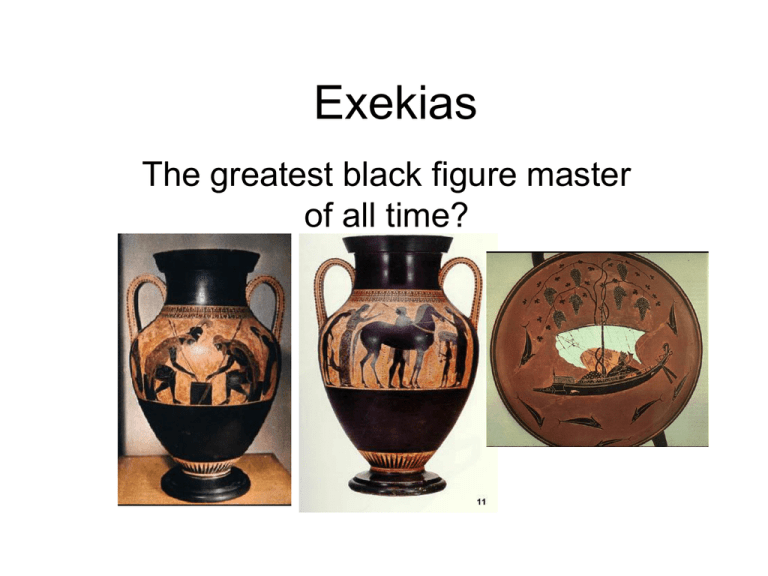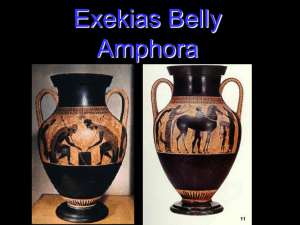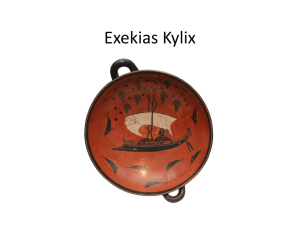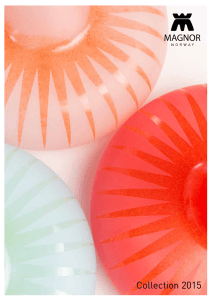Exekias
advertisement

Exekias The greatest black figure master of all time? Proscribed Vases: Exekias Belly Amphora Side A Achilles & Ajax Proscribed Vases: Exekias Belly Amphora Side B Return of Castor & Pollux Proscribed Vases: Exekias eye kylix dionysus Exekias Belly Amphora Vase: Belly Amphora Potter & Painter: Exekias signed Date: 550 - 540 B.C. Height: 61 cm Subject: Side A: Achilles & Ajax Side B: Return of the Dioskouri Exekias Side A • Exekias signed both as potter and painter. His masterpiece is the belly amphora in Vatican, dated to c.540-530. Its detailed representation, especially the patterns on garments and armours, cannot be found any other painter's works. The myth: Side A • Achilles was the brave Greek hero in Homer's Iliad. When Achilles was a baby his mother Thetis dipped him into the river Styx. The magic water protected his body, except for his heel, which his mother was holding. Achilles was killed in the Trojan War when Paris’ arrow struck him on the heel. The Tragedy of Ajax • Ajax recovered Achilles body when Paris shot Achilles. • Athene gave achilles armour to Odysseus so he boasted he did not need the gods help • Athene drove him mad and he killed cattle in the belief they were the enemy. • Ajax committed suicide due to the shame Subject side A: A game • This vase shows Ajax and Achilles two Greek heroes playing a game similar to backgammon. • Herodotus, the 5th century Greek historian believed board games came from Asia Minor. Counters, dice and game pieces made of stone, bone and clay have been found. Composition Side A • The painter made viewer's eyes concentrate on the board at the centre led by the heroes' eyes, hands and spears. Composition Side A • Also the spears lead our eyes to the handles. Composition Side A • Although the figures are symmetrically arranged, Exekias differenciate both figures in every detail. • list the differences you can see Composition Side A • It is also noticeable that depth is represented by overlapping spear, board, legs and mantles. Composition Side A • The composition complements the form of the vase. • Figures are bent toward game and curve of their backs echoes curve of vase. Composition Side A • Their spears lead the eye up toward the handles. Composition Side A • The shields continue the vertical line of the bottom of the handle. Composition Side A • Each man is shown with a helmet. Treatment of the figure • Archaic frontal eye in profile head • Note the large eyeball and elongated whites of eyes. Leather corset • Leather corset with plates at waist for protection and ease of movement • Worn with chiton underneath Greaves and thigh guards • Greaves are like cricketers knee pads. • Fastened behind knee using thongs • Usually metal; bronze or iron • Note circled areas on the vase Crest • Made from horse hair to distinguish fighters and make leaders more visible to their men • Achilles is wearing his to make him the larger figure. • Note the flopply crest and the tail trailing down the side of helmet Treatment of the figure • Achilles Clothing • Label these items on your pictures in your books. • NB there is no 6 Side B: Return of the dioskouroi • Kyllaros, the horse tamed by Castor, dominates the scene. Behind is Castor. On the left side welcoming her sons is Leda and Polydeuces patting the hound. On the right is Tyndaros king of Sparta and servant boy carrying blankets/ cloacks and arabollos filled with oil or perfume for the travellers. Da Vinci’s Leda Leda and the swan; dali The Myth in brief • Leda was the Spartan queen, wife of Tyndareus and mother of the double sets of twins, Castor and Polydeuces and Clytemnestra and Helen. • The best known story is that Zeus disguised himself as a swan and seduced Leda. Thus Leda's children hatched from two eggs that she produced. • It appeared that on a single night Zeus, in the guise of a swan, lay with Leda, who conceived Polydeuces (Pollux) and Helen "of Troy“. Later the same night her mortal husband, Tyndareus, king of Sparta, lay with his wife too, and she conceived Castor and Clytemnestra. • Thus one set of twins were wholly mortal Castor and Clytemnestra, the other set half-immortal Polydeuces and Helen "of Troy" . Castor and Polydeuces • In Greek mythology, Castor (or Kastor) and Polydeuces (sometimes called Pollux) were the twin sons of Leda • They are called the Dioscuri (dios kouroi), meaning the "Sons of Zeus", • They are known as the Gemini, Latin for twins. • Polydeuces was a powerful boxer, and Castor a great horseman. • Castor and Polydeuces abducted and married Phoebe and Hilaeira, the daughters of Leucippus. In return, Idas and Lynceus, nephews of Leucippus (or rival suitors), killed Castor. • Polydeuces was granted immortality by Zeus, and persuaded Zeus to share his gift with Castor. Accordingly, the two spend alternate days as gods on Olympus and as deceased mortals in Hades. Exekias Kylix Vase: Kylix Potter & Painter: Exekias signed Date: 535 B.C. Diameter: 30.5 cm Subjects Interior: Dionysus Exterior: pair of apotropaic eyes Exterior under handles: Hoplites fight over bodies of fallen. Foot signed by Exekias Exekias Kylix • It was found in the Etruscan city of Vulci in Italy and is thus part of the abundant evidence of lively trade in the ancient Mediterranean. • It is now in the Staatliche Antikensammlungen of the Bayerisches Staatsministerium für Wissenschaft, Forschung und Kunst in Munich. It is known as munich 2044 Signing vases • We know the names of some potters and painters of Greek vases because they signed their work. Generally a painter signed his name followed by some form of the verb 'painted', • While a potter (or perhaps the painter writing for him) signed his name with 'made'. • Sometimes the same person might both pot and paint: Exekias for example, sign as both potter and painter. • At other times potter and painter were different people and one or both of them signed. Like the francois vase • However, not all painters or potters signed all their work . Some seem never to have signed their vases, unless by chance signed pieces by these craftsmen have not survived. Inscriptions • It is signed by Exekias, a potter and painter working in Athens in about 530 BC, .On foot of opposite side: see C&H pg 30 ECHSEKIAS EPOESE ("Exekias made it") Shape • Cup for wine drinking • Exekias introduced new shape is so called ‘A type’ which has a shallow bowl with plain lip and a splaying foot offset from the bowl. Interior decoration • The tondo has Dionysos lying on his ship surrounded by dolphins. Exekias filled around the tondo with coral red, though this technique was rarely followed. Decoration Interior • Dionysos in a ship, sailing amongst dolphins. Decoration Interior • Dionysos reclines like a symposiast in his ship, holding a keras or rhyton (drinking horn) in his right hand and leaning back on his left arm. Decoration Interior • The white sail of the ship spreads above him, and climbing the mast of the ship, a grapevine with clusters of grapes fills the field of the cup. Decoration Interior • The prow of the ship is decorated with eyes; the body of the ship with two leaping dolphins and the stern post bends up into a swan's head. A random modern version of myth without Dionysus but a bear instead? The Myth • Based on Homer’s ‘Hymn to Dionysos’ • Dionysus was kidnapped on the way to Greece by pirates. • He revealed his divine persona by turning the mast into a vine which grow vines which produced grapes, as Dionysus is the god of wine. • The terrified pirates jumped overboard and turned into dolphins. Exterior decoration • On both sides A and B, large apotropaic eyes like those on East Greek cups, with eyebrows and diminutive noses. Exterior decoration • Beneath and on either sides of the handles, battles over fallen heroes (fight for the body of Patroklos?). Exterior decoration • The warrior has already been stripped of his armor. Armour is the prize of the victors Exterior decoration • On this side, he is armed. Development of Black figure • In Athens, in the Archaic period, potters made clay pots with mythological scenes on them. • Gradually the scenes grew and took over more of the pot, and the geometric decoration took up less and less space. • At the same time, a new painting technique developed. Instead of painting figures of people in outline, the Athenian potters began to paint people in silhouette: this is called black-figure, because the people are all black. Making and decorating Athenian black figure vases •The first stage in making a pot is to dig the clay out of the ground. Pieces of grit or plant matter must be removed before the clay can be used. This was done in ancient times, as it is today, by mixing the clay with water and letting the heavier impurities sink to the bottom. This process could be carried out as many times as necessary. When judged to be sufficiently fine, the clay was left to dry out to the required consistency. Making a pot • To make a vase the potter kneaded a lump of clay of suitable size and placed it centrally on the flat surface of the wheel. As the wheel revolved, the potter drew the clay up into the required shape with his hands. Making a pot • Scenes on the vases themselves show that potters' wheels were discs, presumably made of wood, clay or stone, about two feet in diameter, with socketed bases fitting over low, fixed pivots. It seems to have been usual to have a boy, presumably an apprentice potter, to turn the wheel by hand. Making a pot • Particularly large vases were thrown in sections, and in the case of shapes such as cups, the foot would be thrown separately from the body. The handles of most shapes were hand-made. When all the components had been allowed to dry for about twelve hours, they were glued together with clay slip. Firing a pot • Black figure is done all with one type of clay. The clay found near Athens has a lot of iron in it, so it looks black when it is wet. But if you fire it in an oven where there is plenty of air getting in, the clay rusts, and turns red. This is because the iron mixes with the oxygen in the air. If you fire it in an oven with no air getting in, the iron can't mix with oxygen, and the pot stays black. So you can have either red or black pots. Firing a pot • So how do you get a picture? You make a pot the regular way, and let it dry a little ("leather-dry"). Then you mix a little of the wet clay with a lot of water, to make a kind of paint (called the slip), which you use to make the black part of the picture. (You can't see it now, because it is all the same color). And you let the whole thing dry. Firing a pot • When it is dry, you fire it in a kiln. First you give it a lot of air, so the whole pot turns red, slip and all. Then you shut off the air supply, but just for a little while right at the end of the firing. When the air runs out, the fire sucks oxygen right out of the clay of the pot. But the places where there is slip, the slip is thinner and easier to suck air out of. So the slip turns black (the color of iron with no oxygen in it) faster than the rest of the pot (which is red, the color of iron with oxygen in it). Firing Athenian black- and red figure vases • A distinctive red and black colour scheme characterises most of the painted pottery of sixthand fifth-century Athens. The colours result from the skilful exploitation of the high iron content of Athenian clay by an ingenious process of differential firing. The black areas of a black or red-figured pot were coated in a fine solution of the same clay that was used for the body of the vase. Before the vase was placed in the kiln, it would have been orange-red in colour, with the coated areas slightly deeper in tone. D. Williams, Greek vases (London, The British Museum Press, 1999) Firing step 1 • Once the kiln had been loaded, the a threestage firing took place. In the first, oxidising, phase plenty of air was allowed into the kiln, and the temperature was gradually made to rise to around 800º C. At this point, the vase turned a bright orange-red, as the oxygen in the atmosphere combined with the iron in the clay to produce (red) ferric oxide. D. Williams, Greek vases (London, The British Museum Press, 1999) Firing step 2 • When the potter judged that the required temperature had been reached, he stopped up the air vents and perhaps introduced damp material in the form of green wood or even bowls of water. This produced a reducing (oxygen-poor) atmosphere in the kiln and the red ferric oxide was converted to (black) ferrous oxide, so that the entire pot turned black. The temperature in the kiln continued to rise to around 945º C. The intense heat caused the fine particles of the clay of the coated areas of the pot to 'sinter', that is, to fuse together to form a hard, smooth, almost glassy surface. D. Williams, Greek vases (London, The British Museum Press, 1999) Firing step 3 • In the third and final stage, the temperature was allowed to drop, and at about 900º C the ventilation holes were opened up, oxygen returned to the atmosphere of the kiln, and the ferrous oxide of the uncoated areas converted back to ferric oxide, so that as the kiln cooled down these parts turned orange-red again. The sealed surface of the sintered areas was impervious to the presence of the oxygen and so remained black. • D. Williams, Greek vases (London, The British Museum Press, 1999)










